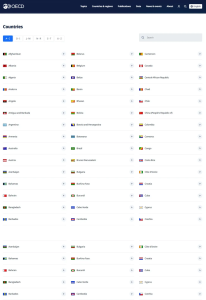As global tax compliance requirements continue to tighten and financial and tax regulations become increasingly stringent, an growing number of Chinese high-net-worth individuals and businesses are considering establishing overseas tax identification numbers and expanding their operations abroad to optimize their assets and alleviate compliance pressures.
In this context, the Malaysian Tax Identification Number (TIN) has emerged as an attractive option due to its advantages, including convenient registration, no residency requirements, and clear information exchange pathways. Additionally, as a key economic hub in Southeast Asia, Malaysia holds inherent appeal for Chinese enterprises, offering opportunities such as the “Dual Giant Industrial Park,” technical and resource cooperation, policy support, and geographical advantages, all of which present promising prospects.
Malaysia has fully implemented the Tax Identification Number (TIN) system, requiring individuals, businesses, and foreign nationals to be included in a unified management system. This not only relates to tax filing and compliance but also involves bank account opening, cross-border investment, and future digital tax trends. Understanding the TIN is essential to navigate the new regulations with confidence.

I. Overseas Tax Identification Numbers:
A Essential Tool for High-Net-Worth Individuals’ Asset Allocation?
1. Upgraded Domestic Tax Audits: Golden Tax Phase IV and Precision Management
China’s tax system is accelerating the construction of “Golden Tax Phase IV,” which aims to achieve precise tax audits through the integration of big data and internet intelligence across tax, social security, account, and credit systems.
Golden Tax Phase IV was piloted in multiple provinces and cities in 2023 and is expected to be fully implemented by 2024. This means that tax compliance risks have significantly increased, and it has become more difficult for high-net-worth individuals to evade regulation through traditional asset allocation methods.

Image source: Lianhe Zaobao
2. Global Taxation and Cross-Border Information Exchange Under the CRS Policy
The Common Reporting Standard (CRS) is an automatic cross-border financial account information exchange mechanism established by the OECD to combat cross-border tax evasion. Member countries require financial institutions to identify their customers’ tax residency status, collect account information, and exchange it regularly.
Since China joined CRS in 2018, authorities can track overseas account information through agreements; for example, if someone uses Chinese identification to open an account in Singapore, the bank will send the data to the Singapore tax authority, which will then feed it back to the Chinese tax authority. This process is completed by September 30 each year.
Clearly, CRS transmits information on high-net-worth individuals’ financial assets overseas back to their country of nationality, significantly increasing compliance pressure.

Source: OECD
3. How to optimize tax planning and avoid information flow back using overseas tax IDs
CRS information exchange is based on “tax residency status.” If an account is opened using a tax ID from a country other than the individual’s country of nationality (e.g., a Malaysian tax ID), even if the account holder holds a Chinese passport, financial institutions will identify them as a Malaysian tax resident, and their account information will be reported to the Malaysian tax authorities rather than China.
This alters the information flow at its source, preventing CRS information from being transmitted back to Chinese tax authorities, thereby achieving reasonable asset planning and privacy protection.

II. Malaysian Tax ID:
Application Process, Required Documents, and Supporting Services
1. Key Advantages of a Malaysian Tax ID
① No Tax Liability: As long as income does not originate from or is not remitted to Malaysia, the Malaysian tax authorities will not impose taxes;
② Low Approval Threshold: No residency or background checks are required to apply for a Malaysian tax number; only the first page of the passport is needed;
③ Short Processing Time: The service is completed within approximately seven working days from application to document issuance;
④ Comprehensive Support: The service includes provision of a Malaysian phone card and address proof (utility bill), facilitating overseas account opening and identity verification.
This combination of convenience and low cost makes it a new option for high-net-worth individuals’ asset planning.

Image source: Malaysian HASIL
2. Application Process and Required Documents
The entire process is straightforward:
Sign the contract and make payment to initiate the application (1–2 days);
Submit the required documents, including a clear and complete scan of the first page of your passport (1–2 days);
The tax ID number is issued and mailed (3–4 days).
3. Upon completion of the application, the service provider will provide the following supporting documents:
Official tax ID document from Malaysia;
Phone card as proof of communication;
Bank statement as proof of address. These supporting documents are crucial for subsequent overseas bank account openings.
Additionally, the authenticity of the tax ID can be verified through the official website of the Malaysian Inland Revenue Board.

Image source: Malaysia HASIL

III. Chinese Enterprises Expanding into Malaysia:
Opportunities and Strategic Advantages
1. Chinese investment in Malaysia continues to grow
As of the end of 2023, China’s cumulative direct investment stock in Malaysia reached US$13.48 billion, ranking 15th among the top 20 countries (regions), accounting for approximately 0.5% of China’s total outbound investment.
In 2022, China was the largest foreign investment source for Malaysia, accounting for 33.9% of the total approved foreign investment. Companies such as Vanke and CRRC have leveraged Malaysian projects to establish a strong presence in local manufacturing and infrastructure sectors.
2. Malaysia’s strategic location and economic policy support
① Beneficiary of the “China-plus-one” model
The unstable global trade environment has driven the need for “capacity transfer and supply chain diversification.” Malaysia, with its geographical proximity and stable policies, has become the preferred choice. The Minister of Economy noted that as the US imposes tariffs on China, Chinese chip and high-tech companies are accelerating their布局 in Malaysia. Malaysia emphasizes the attractiveness of foreign investment in high-tech fields such as semiconductors and AI.
② Regional economic integration and high-growth engine
Malaysia and Singapore have collaborated to establish an economic zone, which is expected to generate an additional 26 billion US dollars in economic growth by 2030, creating numerous job and project opportunities.
③ Financial and Investment Support Mechanisms
Recently, China Galaxy Securities and China International Capital Corporation (CICC) plan to invest over 1 billion US dollars to establish a Southeast Asia investment fund, with 100 million US dollars specifically allocated to support Malaysia’s gaming industry, driving the development of AI, green energy, and digital infrastructure.
④Close China-Malaysia Relations Ensure Policy Benefits
Bilateral cooperation covers infrastructure projects under the Belt and Road Initiative (such as the East Coast Railway and the Kuantan Industrial Park) and policy reciprocity, such as mutual visa exemptions for short-term stays, enhancing investment convenience.

Image source: Pexels
3. Trend toward strategic shift in Southeast Asian markets
As the global investment environment tightens, Chinese enterprises are shifting their overseas investments from Europe and the US to emerging markets in Asia. Research by Rhodium Group and others indicates that an increasing number of enterprises are reducing their reliance on mergers and acquisitions and gradually shifting their investment targets toward countries such as Malaysia through greenfield projects.
In 2024, China’s outbound direct investment reached US$162.8 billion, up 10% year-on-year; non-financial investment grew by 11%. Investment in ASEAN countries has significantly increased, with Chinese companies actively expanding into manufacturing, infrastructure, and new technology sectors.
Overall, Malaysia aligns well with Chinese companies’ “going global” strategy through policy support, industrial upgrading, and geographical advantages, positioning it as a potential new highlight for Chinese capital.
【Conclusion】
In an era of intensifying tax compliance pressures and stricter global capital regulation, Malaysia’s tax identification number offers high-net-worth individuals a safer and more efficient path for tax identity planning.
Meanwhile, as a key growth opportunity in Southeast Asia, Malaysia provides Chinese enterprises not only with vast market and industrial development space but also policy and capital support advantages. Whether it is asset allocation or corporate internationalization, Malaysia is increasingly becoming an indispensable hub.
Note: Reference materials sourced from Malaysia Mytax, HASIL, CRS, OECD, Singapore Straits Times, and compiled from comprehensive news reports. Reproduction must credit the source; contact for removal if infringing…..
